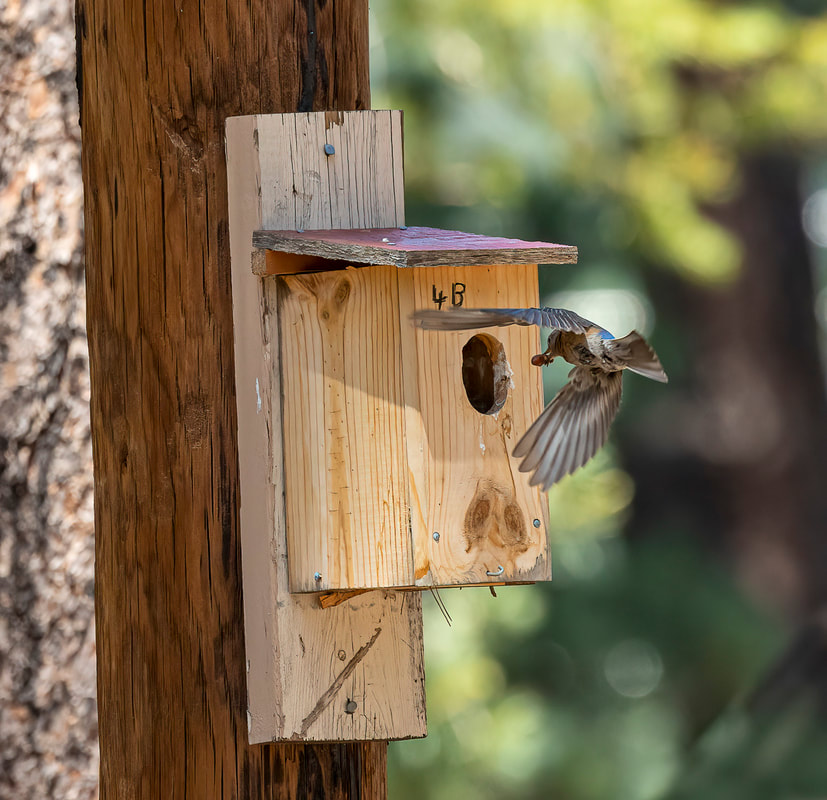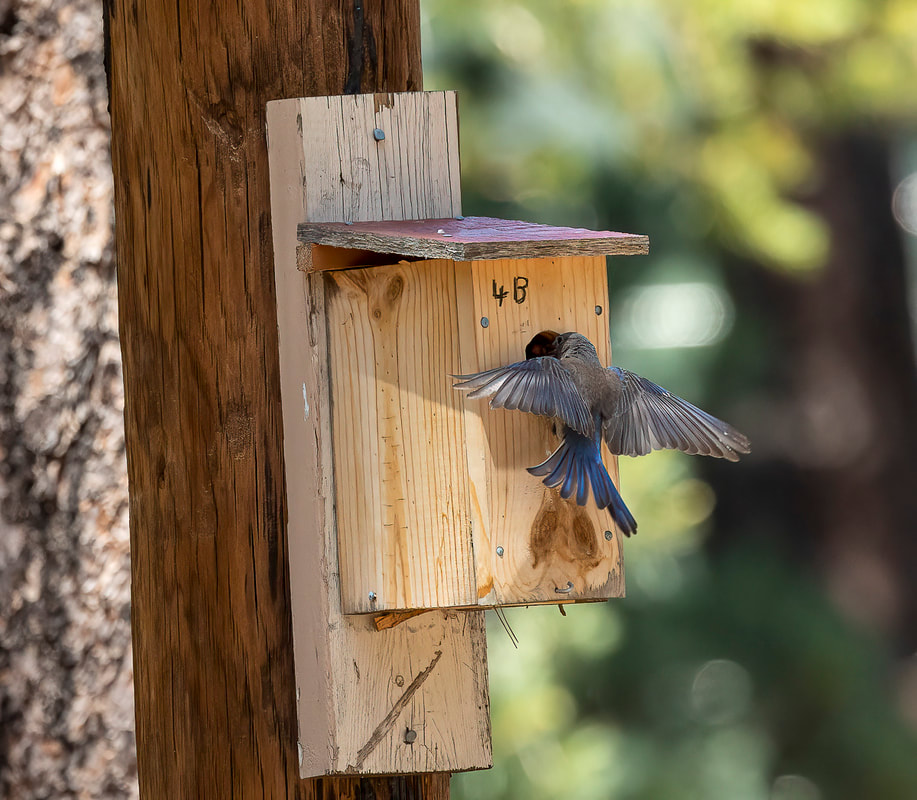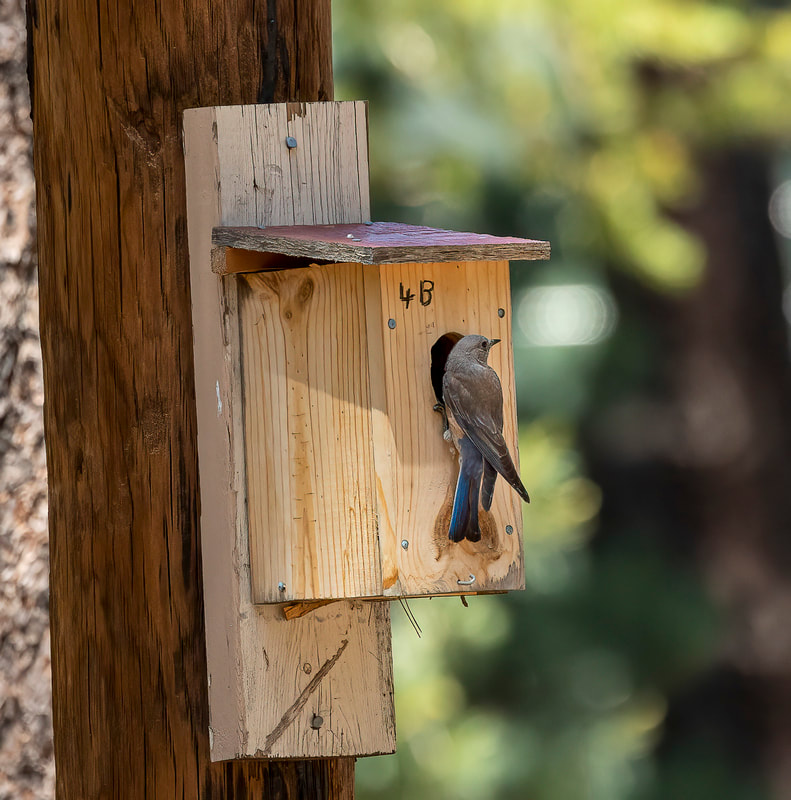|
Red-faced Warbler in Marshall Gulch on May 21, 2024, gathering dry grasses for a ground nest. Birds are born to do four things: Eat, don't get eaten (get lunch before you are lunch!), make more birds (breed), and molt (gotta get a new set of feathers every year to look your best!). Every day is a day to find food and eat. Spring is the time when the hormones kick in and birds find a mate and build a nest (not necessarily in that order) and make more birds! So let's take a look at some of Mt. Lemmon's avian residents in April and May and see how they eat (without being eaten) and breed! Red CrossbillCanon R6, RF100-500mm with 1.4x Ext. at 700mm, 1/500 sec., f/10, ISO 4000, +1.33 EV.
Mt. Lemmon is in their year round territory, but until April I had only seen single crossbills at some distance on the Meadow Trail. On April 28th, my wife and I were birding with our friends Marty and Jim, and spotted a Red Crossbill on a nearby tree, image above. We then had the privilege and pleasure of watching two Red Crossbills feed on downed cones right in front of us on Middle Sabino Road! Images below. Canon R6, RF100-500mm with 1.4x Ext. at 700mm, 1/500 sec., f/10, ISO 3200, +1.33 EV. The Red Crossbills above and below are males, reddish overall with darker wings. The tips of the bills are curved with crossed mandibles. In the image below, a male is feeding on a fallen cone where the scales have already spread. Red Crossbills usually feed on cones in the trees, with scales open or closed. The bills are perfectly suited for extracting seeds from the cones, but don't appear so handy for doing much else! Below the male has just removed the seed "feather" (now in his mouth), which, when attached to the seed allows it to ride the breezes and distribute itself away from the parent tree. Canon R6, RF100-500mm with 1.4x Ext. at 700mm, 1/500 sec., f/10, ISO 3200, +2 EV. Below, he drops the seed feather which falls toward the ground. Seed feather out of the way, he digs in with his bill . . . and comes up with a seed! What we call Pine nuts are really seeds, although the nut designation can be helpful for people with nut allergies, since the pine seeds (AKA nuts) can trigger allergic reactions in some individuals. So, thinking of them as nuts has some advantages. The crossed bills are great for harvesting cone seeds, but can otherwise be a challenge. Below are images of male and female Red crossbills trying to get a drink of water at Dave Jasper's feeders in Portal, AZ, in May of 2018. Canon 7D Mk II, EF100-400mm at 400mm, 1/400 sec., f/9, ISO 1600, +1 EV. With each "drink" most of the water runs out, but some is retained and swallowed with the head tilted back. All birds wake up every morning looking for food. If supplies dwindle in the local area, it is time to move on and find new supplies. Birds who can eat almost everything, like Common Ravens, have lots of options in times of scarcity, and their range is pretty broad. Dietary specialists like the Red Crossbill have to follow the cone/seed supply. This change in food source can create what is known as an "irruption", a sudden change in population density due to movement in times of low food availability. These irruptions in turn create very broad range-maps, with birds suddenly coming into a region for as long as the food lasts, then moving on. Irruptions can be a boon to birders, bringing otherwise rare species into their areas from time to time. We were really fortunate to see Red Crossbills up so close and feeding on downed cones. Look for them this summer on the mountain; they seem to be finding food. Red crossbills nest high in the trees, so getting a peek at a family can be tough, but chances are they are breeding locally right now. Red-faced Warbler
April and May brings Red-faced Warblers back to the Catalinas to breed. The image below is a male in Summerhaven on May 19th, looking for insects and larvae under leaves in the understory. The male has a bright red face, throat and neck with a black bonnet with a white patch in the back. The female is similar, but more of an orangish color. Canon R6, RF100-500mm with 1.4x Ext. at 700mm, 1/2000 sec., f/10, ISO 40000, +1.67 EV. Canon R6, RF100-500mm with 1.4x Ext. at 700mm, 1/1000 sec., f/10, ISO 4000, +1 EV. Above and below, a Red-faced Warbler looking for insects in the understory. They will flick their tail, or a wing (below) in a fashion similar to the Painted Redstart in order to scare insects out of hiding and into their visual field. Because they search low on deciduous leaves, they are easier to spot than birds who prefer the crowns of conifers. On an early morning field trip with Jeff Babson and crew in May, we spotted the Red-faced Warbler shown below, gathering up dry grasses to build a nest. Unlike Red Crossbills, Red-faced Warblers are ground nesters, building well hidden nests on slopes or the base of trees. The nest site is chosen by the female, who then builds it on her own, while guarded by the male. Males may build another nest nearby, but never complete it or use it. Here we see a male building a nest right next to the road. The "real nest" being built by his mate may be nearby. (Ref: All About Birds, and Birds of the World). Canon R6, RF100-500mm with 1.4x Ext. at 700mm, 1/500 sec., f/10, ISO 16000, +0.33 EV. In the spirit of full disclosure, I saw two nests being built in May, both by males, very close to each other. The gathering of grass shown above was on Tuesday the 21st, being taken to a nest higher up on the slope and out of sight. The nest shown below was spotted on Sunday the 19th, beside the road. Gathering grasses for the nest involves the Goldilocks Principle, get enough to make the trip worthwhile, but not so much you cannot see or fly! Below, he lifts his wings and tail, perhaps a pre-flight check! The nest below was adjacent to the road, dug into loose dirt and covered with grasses. There was one spot from across the road to view the nest opening. In the next frame we can just spot our male Red-faced Warbler to the right, a spot of red, perched on a branch waiting to be sure his path is clear. He launches himself into the air . . . . Canon R6, RF100-500mm with 1.4x Ext. at 420mm, 1/5000 sec., f/10, ISO 3200, +0.33 EV. And brakes for a landing . . . . After some time for nest construction, he peeks out to be sure the coast is clear, and takes off following the same route back out. As noted earlier All About Birds reports that the female chooses and builds the nest, although the male may build another nest nearby that does not get used. I am pretty sure that this is a male based on the bright red coloration of the head, so this is likely a secondary nest that will not be used. Although pure conjecture on my part, it is possible that male nest building is a ruse to divert predators away from the real nest. Western BluebirdCanon R6, RF100-500mm with 1.4x Ext. at 700mm, 1/1250 sec., f/10, ISO 2500, +0 EV. So far we have seen a tree nester (Red Crossbill) and a ground nester (Red-faced Warbler), so now let's look at a cavity nester, the Western Bluebird. The photograph above is a male Western Bluebird, captured on April 28th, in Summerhaven. The images below were captured on June 19, 2022, off of Loma Linda Extension Road. Canon R6, RF100-500mm at 500mm, 1/1600 sec., f/8, ISO 2500, +0.33 EV. Western Bluebirds are cavity nesters, usually using existing holes in living or dead trees. Where tree holes are scarce, Western Bluebirds like nest boxes, similar to the one shown here provided by one of our industrious neighbors on the mountain. Above and below, a female is bringing in a large bug for her brood, June 19, 2022. After delivery, below, she pauses to look around, always looking for predators. June is breeding time on the mountain, so keep your eye on the nest boxes scattered around the community and look for activity. Next . . . . . The Hairy Woodpecker, another cavity nester . . . .Canon R6, RF100-500mm with 1.4x Ext. at 700mm, 1/1000 sec., f/10, ISO 1600, +0 EV.
Canon R6, RF100-500mm with 1.4x Ext. at 508mm, 1/320 sec., f/22, ISO 10000, +1.67 EV. Plumbeous VireoCanon R6, RF100-500mm with 1.4x Ext. at 420mm, 1/1000 sec., f/10, ISO 1600, +0.33 EV.
The Plumbeous Vireo has white eye-rings that are connected with a white band above the bill to create "spectacles" which we can see in the photographs above and below. Plumbeous Vireos feed on insects, foraging carefully, preferring pine trees rather than the deciduous understory. For the photo geeks: Plumbeous Vireos move slowly, and will pause looking for food, but higher up in conifers, maxing out your telephoto and your neck! The Red-faced Warbler on the other hand sticks to the lower understory at eye level, but moves very fast, and in low light. No one said it would be easy . . . . Plumbeous Vireos nest on Mt Lemmon, as shown in the images below, captured on July 11, 2021 on the Meadow Trail. Canon R6, EF100-400mm with 1.4x Ext. at 560mm, 1/1000 sec., f/11, ISO 10000, +0.67 EV. The male picks the nest site and shows it to the female. If she accepts the location, she does most of the building, creating an open cup suspended from a forked tree branch, using grasses, rootlets, bark strips. and hair. In the three images below we see the female (or perhaps a male) feeding insects to one of the two nestlings, then posing for a portrait! Keep your eyes open for nests on the mountain in the coming months. Next . . . . The Broad-tailed Hummingbird, Another Tree Nester . . .Canon R6, RF100-500mm with 1.4x Ext. at 420mm, 1/1000 sec., f/10, ISO 4000, +0.67 EV.
Canon R7, RF100-500mm at 123mm, 1/2000 sec., f/7.1, ISO 6400, +0.33 EV. Canon 7D Mk II, EF100-400mm with 1.4x Ext. at 328mm, 1/1000 sec., f/7.1, ISO 4000, +1 EV. Broad-tailed Hummingbirds have specialized wings that emit an insect-like metallic trill while flying. It can be quite loud and is noticeable around feeders. As the season progresses, the sound becomes muted as the feathers wear, until late winter when the birds molt into new feathers with sound properties restored, ready for another loud and raucous breeding season! (Ref: All About Birds). Finally . . . . The Wild Turkey . . . .Canon R6, RF100-500mm with 1.4x Ext. at 480mm, 1/1600 sec., f/9.0, ISO 800, -0.33 EV. Let's close with a few shots of a male Wild Turkey near Carter Canyon Road, in courting mode, all puffed up and gobbling like mad. There were several males together on April 28th, all trying very hard to get the attention of a nearby group of females, who seemed totally uninterested. Wild Turkeys are native to North America, but in the early 20th century populations were almost eliminated in areas due to hunting. A subspecies, the Gould's Wild Turkey, was introduced into SE Arizona in the early 1980's, initially in the Huachuca Mountains near Sierra Vista, then with transplants going to other ranges, including the Catalinas, Rincons and Santa Ritas. Ref: AZPM News. Wild Turkeys live on the mountain year round, nesting on the ground in dead leaves or plant material at the bases of trees or in the thick understory. Fossil records show that turkeys have lived across the southern U.S. and Mexico dating back more than 5 million years! Ref: All About Birds. That's all for now! More coming soon . . . Keep your eyes and ears open, and don't go out without your binoculars! Happy Trails!
5 Comments
charles
6/5/2024 08:26:21 am
ANOTHER WONDERFUL COMPILATION of excellent photographs complimented with accurate scientific text. Interesting that we do not get crossbills over on this side of the mountain.
Reply
Henry
6/5/2024 01:01:37 pm
Charles, many thanks! We were very lucky to see crossbills on the ground, and eating in full view! I thank Jim and Marty for picking up on this. I find the food specialists especially interesting, especially in this case where their whole jaw/bill anatomy has evolved to do one thing - eat seeds from cones.
Reply
Joseph McCollough
6/5/2024 08:34:09 am
Absolutely gorgeous photos and very educational!! Joe Mc
Reply
Henry
6/5/2024 01:02:18 pm
Thanks, Joe!
Reply
Pam Winsten
6/6/2024 09:14:25 am
Love the photography and narrative. Delightful!
Reply
Leave a Reply. |
AuthorHenry Johnson, photographer and author of this site. For more detail, see About
Categories
All
Archives
July 2024
|














































 RSS Feed
RSS Feed